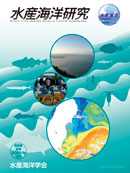
- Issue 4 Pages 191-
- Issue 3 Pages 141-
- Issue 2 Pages 45-
- Issue 1 Pages 1-
- |<
- <
- 1
- >
- >|
-
Tsutomu Tokeshi, Kenji Nakanishi, Satoshi Katayama2021Volume 85Issue 2 Pages 45-53
Published: May 25, 2021
Released on J-STAGE: October 25, 2022
JOURNAL FREE ACCESSTo identify spatiotemporal variations in the coastal resources off Miyazaki Prefecture, we analyzed fisheries catch data for 15 species over 40 years. Additionally, we examined the long-term relationship with oceanographic conditions, taking into consideration the influx of nutrient-rich cold water into the bottom layer of the Bungo Channel. Of the 14 species for which catch was found to correlate with tide levels at Hososhima (Miyazaki), catch for 10 species increased at low tides in conjunction with lower bottom temperatures, while that of the four remaining species increased at high tides. Furthermore, coastal fisheries catch in Miyazaki Prefecture was significantly synchronized with catch for 10 out of 15 species in the Southern Pacific Ocean, which was the highest among the four other maritime zones. Overall, these findings suggest that coastal resource catch in Miyazaki Prefecture is strongly affected by long-term variations in oceanographic conditions on the North Pacific scale, mainly in the form of nutrient-rich cold bottom water, whose influx increases Miyazaki coastal resources.
View full abstractDownload PDF (973K) -
Yutaka Kumaki, Naoki Hirose, Yosuke Igeta, Atsushi Kaneda, Kouta Ayuka ...2021Volume 85Issue 2 Pages 54-68
Published: May 25, 2021
Released on J-STAGE: October 25, 2022
JOURNAL FREE ACCESSIn Wakasa Bay, a stormy current, Kyucho, caused by a meteorological disturbance or Tsushima Warm Current often damages the set-nets. Although the set-net damages caused by Kyucho events frequently occur in the bay mouth, the damage caused by the passage of Typhoon 1102 was concentrated in the bay head. To clarify the generation mechanism of this Kyucho event, a high-resolution numerical model for Wakasa Bay was developed with a horizontal grid interval of 500 m (called DR_W model). Numerical experiments using DR_W model reproduced the Kyucho event well, with input data of the strong northerly wind and Yura River flushing caused by the typhoon. The modeled Kyucho had a maximum speed of approximately 1 m·s−1, a width of less than 10 km, a depth of less than 10 m, and moved from the western to eastern part of the bay head about 12 to 36 hours after the passage of the typhoon. The sea level rise also occurred in the western part of the bay head during typhoon-induced northeasterly winds and moved from the western to eastern part of the bay head after the passage of the typhoon. However, the phenomenon could not be reproduced by numerical experiments using DR_W either with the strong northerly wind or the Yura River flushing (each calculated current speed of less than 0.5 m·s−1 in the bay head). Thus, in the simulation, a large amount of freshwater from Yura River was piled up by the strong northeasterly wind on the western part of the bay head, and the horizontal pressure gradient was generated during the typhoon’s approach to Wakasa Bay. When the typhoon passed, the wind direction changed, the pressure gradient was released, and then gave rise to Kyucho in the bay head.
View full abstractDownload PDF (4548K) -
Satoru Kamohara, Shuichi Shiba, Daiki Tsurushima, Teruaki Suzuki2021Volume 85Issue 2 Pages 69-78
Published: May 25, 2021
Released on J-STAGE: October 25, 2022
JOURNAL FREE ACCESSThe Manila clam (Ruditapes philippinarum) catch plunged to 1/10 of the catch of FY 2013 in FY 2017 in Ise Bay and Mikawa Bay, Aichi Prefecture, Japan. One of the suggested causes is the reduction of phytoplankton content associated with reduced nutrition. Therefore, we examined the relationships between Manila clam growth and the aged changes of chlorophyll a, TN, and TP. We calculated the aged changes of clam soft body weight and gonad weight with a clam growth model using the concentration of chlorophyll a and water temperature. Consequently, from FY 2007 to FY 2017, clam soft body weight continued to decrease below the minimum weight required for survival, and gonad weight was lower from FY 2007 to FY 2017 than from FY 1998 to FY 2006. We hypothesized that the concentration of chlorophyll a, especially from June to November of each year, has a large influence on clam soft body weight and influences habitat. TP had a high contribution rate with chlorophyll a of TP and TN. When clam growth remained stable from FY 1998 to FY 2006, the average concentration of TP from June to November maintained at 56.5 μg・l−1. This value was equivalent to class 3 (50 μg・l−1<TP≤90 μg・l−1) of the appropriate concentration for clams in the quality standards for fishery waters. However, when the clam catch decreased because of continued poor growth from FY 2007 to FY 2017, the average concentration of TP from June to November had decreased to 45.2 μg・l−1. This average concentration was equivalent to class 2 (30 μg・l−1<TP≤50 μg・l−1). It is thought that class 3 TP concentration is required from June to November to maintain clam resources.
View full abstractDownload PDF (1430K)
- |<
- <
- 1
- >
- >|